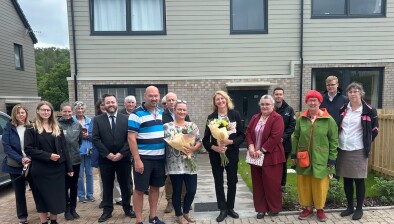Green light for affordable housing plan on banks of Loch Lomond
 Twenty-two new homes are now in the pipeline for Balmaha due to an innovative approach to tackling the issue of the lack of affordable rural housing.
Twenty-two new homes are now in the pipeline for Balmaha due to an innovative approach to tackling the issue of the lack of affordable rural housing.
Planning permission has been granted to Rural Stirling Housing Association to build 20 affordable and social rented homes on land allocated for housing in the Local Development Plan - with permission also granted for two self-build plots - to the east of the village of Balmaha on Loch Lomond.
The approval for the new homes came following a public hearing in Drymen of the Planning and Access Committee of the Loch Lomond & The Trossachs National Park Authority.
The successful application was the result of 15 years of partnership working with the local community and was supported by Buchanan Community Council.
The development comprises a mix of 10 houses and flats for social rent, six houses for low cost home ownership (shared equity) and four cottage flats for local workers to rent. The flats for local workers will be developed in conjunction with East Loch Lomond Community Trust. Two five-bedroom self-build detached plots were also given approval.
Margaret Vass, chair of Rural Stirling Housing Association, said: “This development will help to support the local economy and stem the depopulation of Balmaha due to the high number of second and holiday homes pricing local residents out of the housing market. The new homes will allow local people to remain in the local area with a range of tenure options and help to sustain the community and revitalise the village of Balmaha.
“Most importantly it delivers what the community asked for back in 2003. Balmaha is not unique in having these rural housing issues and we very much hope that the innovative approach used here can be applied to other pressured rural locations.”
 The woodland setting for the development was sensitively considered by designers John Gilbert Architects which will see the homes constructed in white render, with native wood cladding and slate roofs to minimise the visual impact on the surrounding area.
The woodland setting for the development was sensitively considered by designers John Gilbert Architects which will see the homes constructed in white render, with native wood cladding and slate roofs to minimise the visual impact on the surrounding area.
In addition to native species of trees being planted on the site, a further 1.5 hectares of native trees will be planted in another area of the National Park as a compensatory measure for the trees that will be removed.
Petra Biberbach, chair of the Planning & Access Committee at Loch Lomond & The Trossachs National Park Authority, said: “Housing is a key issue in the National Park, which is one of the most expensive places in Scotland to buy a home. This combined with the ageing population of the area, means it is increasingly difficult for younger, working age people and families to live in the Park. That has a knock on effect for the sustainability of communities.
“The need for more affordable housing has been identified by the community in and around Balmaha through consultation on the Local Development Plan and is something the Park and our partners aim to address through the National Park Partnership Plan over the next five years.
“Whilst some trees in the area will have to be removed to allow the development to go ahead, the trees earmarked for removal have been identified as young and not considered ancient woodland. The mature oak trees which are the most valuable feature of the woodland will remain and further planting of native species at the site is planned.
“The National Park is a beautiful and important landscape, but it also supports living working communities that need well-considered developments like this to be able to grow sustainably and encourage younger, working age people to live and work in the area.
“We recognise that there have been strong views both for and against this proposal. This was a well-considered application and we are confident that the balance has been struck between creating much needed new homes in a way that is sensitive to the special qualities of the environment.
“This development is a great example of the vision set out in our National Park Partnership Plan being brought to life.”
 The National Park Partnership Plan 2018-23 sets out 13 key outcomes that the Park Authority and its partners aim to address over the next five years.
The National Park Partnership Plan 2018-23 sets out 13 key outcomes that the Park Authority and its partners aim to address over the next five years.
This includes Outcome 12: Sustainable Population: “Population decline is being addressed by attracting and retaining more skilled working age and young people within the National Park and a better range of housing options.”
The development will be supported by grant funding from the Scottish Government. Construction is expected to commence on site in March 2019 with completion planned for 12 months later.















